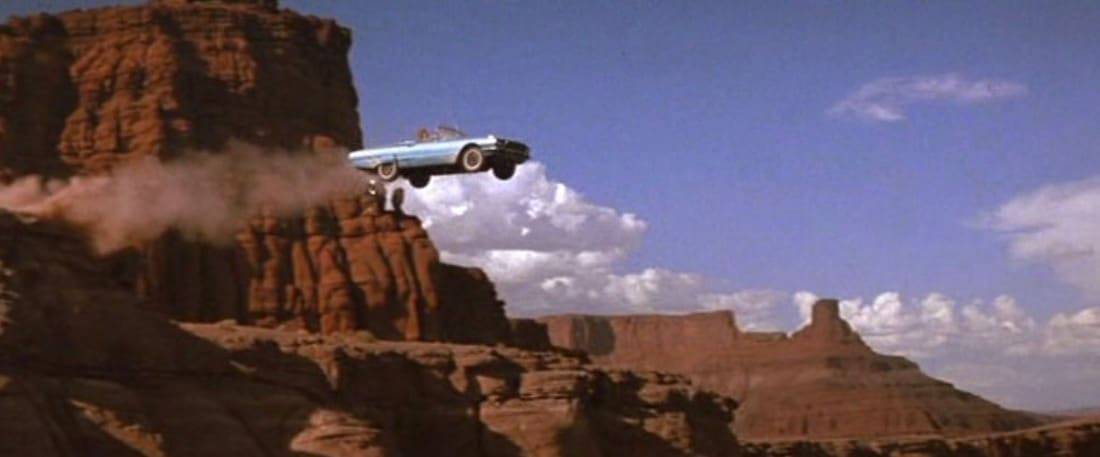This article is part of our One Perfect Archive project, a series of deep dives that explore the filmmaking craft behind some of our favorite shots. In this entry, we discuss how Ridley Scott’s Thelma & Louise executes the technique of the freeze frame.
The best use of a freeze frame for the final shot in a film isn’t The Breakfast Club, it’s Thelma & Louise. The 1991 Oscar winner for Best Orginal Screenplay shows the transformation of isolated housewife Thelma (Geena Davis) and cigarette-loving waitress Louise (Susan Sarandon) into the notorious eponymous duo on the run to Mexico. Essentially, it’s the feminine manifesto on how to leave domestic life behind for the freedom of being outlaws.
One of the most memorable moments of the film is the ending. After an intense police chase through the desert, Thelma and Louise choose to drive their ’66 Thunderbird off of a cliff rather than being caught by the police. However, the audience doesn’t see the actual crash. Aided by a powerful and emotional score from Hans Zimmer, the car freezes in mid-air and the screen fades to white.
The freeze-frame ending creates ambiguity by never confirming the women’s deaths. In this way, it is reminiscent of Butch Cassidy and the Sundance Kid, in which the titular characters’ story ends in a freeze frame before they presumably go out in a blaze of glory. Instead of being a dreary, expected fate for the outlaws, the scene almost feels hopeful. This idea is the same for Thelma & Louise. When the Thunderbird freezes in mid-air, it exemplifies the film’s theme of freedom as the women were able to take control of their fate.
However, this wasn’t the only ending proposed for the film. Although it’s not marginally different than what was ultimately used, an alternate ending included on the film’s DVD release shows the moment that happens just after the freeze frame; here, the Thunderbird makes its descent into the canyon as Investigator Hal (Harvey Keitel) and the rest of the police can only watch. The film ends with Thelma and Louise driving off into the distance, presumably in the afterlife.
The assumed afterlife scene occurs in the same location as the opening credits, giving the impression that the women were destined to die in that canyon from the beginning. This scene would thus hurt the film’s message of freedom since it takes away any autonomy the women thought they had. If they were destined to die, then everything that led them to that moment on the cliff was not their choice. This implies there was nothing the women could have done to change their fate.
With that said, the DVD release didn’t show the only different ending for the film. According to an Entertainment Weekly interview with Sarandon, another alternate ending was discussed between her and director Ridley Scott. “He said, ‘You might push her out of the car or something,’” she recalled.
Thankfully, this ending remained theoretical and did not make it into the final cut. After all, if Louise saved Thelma, the entire message of the film would have changed. No longer would it be the two women against the world, but rather one of them paying the ultimate price to save the other. This action ruins the moment when Thelma says “something’s, like, crossed over in me and I can’t go back,” since it would be Louise condemning Thelma to return to her old life and face the consequences for both of their actions. Pushing Thelma out of the car would save her life, sure, but the life she’d go back to would not be the one she wants to live anymore.
With the actual ending, on the other hand, both women choose their destiny together. This ends the argument of whose fault it is for why the women are on the run, whether it was Louise for shooting Harlan (Timothy Carhart) when he attacked Thelma or if it was Thelma for the armed robbery. By making their final choice together, they both accept fault. The film emphasizes this decision by ending with the Thunderbird in mid-air, where no clear fate is defined for the women except for the one they chose. Thus, the final freeze frame sets the women free because nothing can stop their decision to “keep on going.” Not their old lives, not the police, and certainly not gravity.

